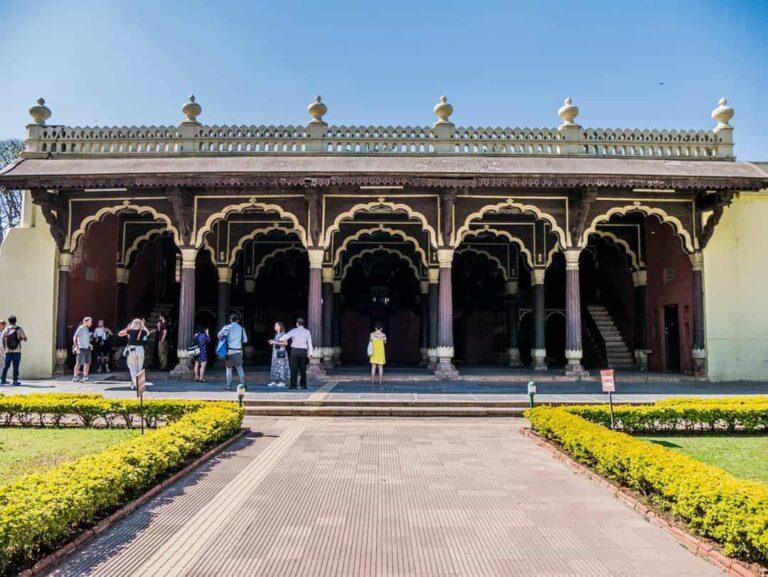Tipu Sultan’s Summer Palace is a historical monument located in Bangalore, Karnataka, India. It was built by Tipu Sultan, the ruler of the Kingdom of Mysore, in 1791. The palace showcases a fine example of Indo-Islamic architecture, featuring intricately carved arches, pillars, and balconies. The structure served as Tipu Sultan’s summer retreat during his reign. Today, it stands as a popular tourist attraction, offering visitors a glimpse into the rich heritage and culture of the region.

tipu sultan’s summer palace tickets
As of my last update, the ticket prices for Tipu Sultan’s Summer Palace in Bangalore, India, were as follows:
- For Indian citizens: ₹15 (adults), ₹10 (children)
- For foreigners: ₹200
1. Introduction
Nestled in the heart of Karnataka, India, Tipu Sultan’s Summer Palace stands as a testament to the rich cultural and architectural heritage of the region. This majestic structure, often referred to as the “Abode of Pleasure,” offers visitors a glimpse into the opulent lifestyle of one of India’s most iconic rulers.
2. Historical Background
– Early Life: Tipu Sultan, also known as the Tiger of Mysore, was born in 1751 in Devanahalli. He inherited the throne of the Kingdom of Mysore after his father’s demise.
– Rise to Power: Known for his military prowess and strategic acumen, Tipu Sultan expanded his empire through various conquests and alliances, earning him both admiration and fear from his contemporaries.
3. Construction
– Architectural Style: Built during the 18th century, Tipu Sultan’s Summer Palace showcases a unique blend of Indo-Islamic architecture, characterized by ornate arches, intricate carvings, and vibrant colors.
– Unique Features: The palace boasts exquisite craftsmanship, with intricately designed wooden pillars, ornamental frescoes, and Persian inscriptions adorning its walls, reflecting the cultural syncretism prevalent during Tipu Sultan’s reign.
4. Significance
– Cultural Importance: As a symbol of Tipu Sultan’s grandeur and patronage of the arts, the Summer Palace holds immense cultural significance, attracting historians, scholars, and art enthusiasts from around the world.
– Historical Relevance: The palace serves as a living legacy of Karnataka’s rich history, offering insights into the socio-political landscape of the region during Tipu Sultan’s rule.
5. Decline and Restoration
– Neglect and Deterioration: Over the years, the Summer Palace faced neglect and deterioration, with its architectural splendor fading amidst urbanization and environmental factors.
– Restoration Efforts: In recent years, concerted efforts have been made to preserve and restore the palace to its former glory, ensuring that future generations can appreciate its historical and architectural significance.
6. Visitor Experience
– Tourist Attractions: Visitors to the Summer Palace can marvel at its majestic halls, intricately decorated chambers, and lush gardens, immersing themselves in the grandeur of Tipu Sultan’s era.
– Guided Tours: Guided tours offer visitors a comprehensive understanding of the palace’s history, architecture, and cultural significance, enriching their overall experience.
7. Surrounding Area
– Gardens and Landscape: The palace is surrounded by well-maintained gardens and landscaped grounds, providing a serene retreat amidst the bustling cityscape.
– Nearby Attractions: Adjacent to the palace, visitors can explore other historical landmarks, including forts, temples, and museums, further enriching their cultural experience.
8. Conclusion
In conclusion, Tipu Sultan’s Summer Palace stands as a symbol of Karnataka’s rich heritage and Tipu Sultan’s enduring legacy. Through its architectural splendor and historical significance, the palace continues to captivate visitors, offering a glimpse into India’s glorious past.
9. FAQs
Q1. What are the visiting hours of Tipu Sultan’s Summer Palace? A1. The palace is open to visitors from 10:00 AM to 6:00 PM, Tuesday through Sunday.
Q2. Are photography and videography allowed inside the palace? A2. Yes, photography and videography for personal use are permitted inside the palace premises.
Q3. Is there an entry fee to visit the Summer Palace? A3. Yes, there is a nominal entry fee for visitors, with discounted rates for students and senior citizens.
Q4. Are guided tours available for visitors? A4. Yes, guided tours are available at scheduled intervals, providing insights into the palace’s history and architecture.
Q5. Can visitors access the palace’s gardens and surrounding areas? A5. Yes, visitors are welcome to explore the palace gardens and surrounding areas during their visit.

